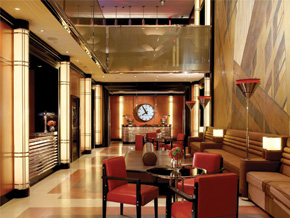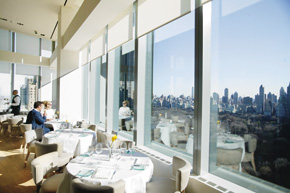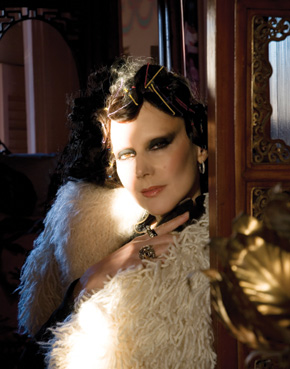|

Urban chic at the Ace Hotel:
a microcosm
of contemporary New York City.
This year, New York has seen the opening of an astonishing
amount of
five-star deluxe properties: two Andaz hotels, a new W, a new
Gansevoort,
an Intercontinental, the Trump Soho, and the Chatwal. Each property
is attempting to bring more to the city than just a decent square
footage of
bedroom with an en suite. In an echo of the 1920s, when New
York social life
revolved almost exclusively around hotels, these new –
or in some cases reinvented
– properties are cultural magnets for tourists and locals
alike. They raise
the bar, make headline news and reinvent whole districts.
A wealth of options on Wall Street
The new Andaz and W hotels that opened this year are integral
to the
rejuvenation of the financial district. The Andaz Wall Street
is one of the finest
and most progressive hotels in the city – complimentary
minibars and WiFi
come as standard, and the rooms are immense in size. Instead
of a TV shoved
against a wall, there’s an island work station that enhances
the feeling of space.
The BLT Bar & Grill at the new W a few blocks away is,
perhaps, the
best restaurant in the neighbourhood, serving refined but muscular
comfort
food: filet mignon and macaroni and comté gratin among
others. It’s all
done so perfectly, and is a blessing for the hedge funders who
recently
snapped up real estate in the area.
Meatpacking boutiques and beyond
Just as the Meatpacking District (or MePa, as some are determined
to call it)
seemed to have peaked, André Balazs’s The Standard
developed a spectrum
of intense social scenes this year and rebooted it.
From its beer garden to
offbeat bingo nights, Balazs creates buzz after buzz. He also
continues to
court notoriety. Although The Standard has stopped actively
encouraging
exhibitionism by its guests in glass-fronted bedrooms overlooking
the new
public High Line park space, the New York Post’s website
still has a gallery of past
peep show escapades.
Far away from the velvet ropes of the Meatpacking District,
the Ace Hotel,
which has its spiritual home in the indie-rock hipster milieu
of Portland
Oregon, is anything but a slouch. Think of it as a Chelsea Hotel
for the
ambition-driven 21st century.
Along with urban art in the lobby and the industrial-chic utilitarian
bedrooms, the Ace has imported the Stumptown Coffee crew. That
line that
you see snaking out of the door and along West 29th Street every
morning
is for the best latte in the country, served by bearded, tattooed,
flat-cap
wearing boys in braces.
There was a time when genuine downtown hotels were a rarity.
When
the Soho Grand opened in 1996, it was almost shocking to be
able to
bed down between the lofts and galleries. Now the area is infested
with
boutique properties alongside Banana Republic, J Crew and Apple.
The Soho Grand’s designer, William Sofield, who also works
regularly for Tom Ford, remembers that it was a difficult as
well as radical addition to the area. ‘There was a lot
of resistance to development in the neighbourhood,’ he
says.
|
 |
‘But people were relieved when we opened. We respected
the roots of what was unique to the neighbourhood, incorporating
the works of local artists and artisans.’
The industrial-plush bent of the interior, including the Grand
Street sidewalks’ round-glass tiling, has always been in
sync with SoHo and, this summer, Sofield returned to create
a sumptuous Club Room and a floor of masculine, plush suites,
with cine-screen Macs and coffee tables made from recycled newspaper.
The hotel has never slipped off the cultural radar for festivals
and, in particular, Fashion Week parties.
‘The paramount rule in my book is to create something
that has a legacy,’ says Sofield. Daring design The new
Manhattan hotel scene is radically different from the Ian Schrager
era, when your room was the size of a postage stamp and you
couldn’t actually visit the bar in your own hotel because
of a private event. There’s too much choice out there for
that to have remained the status quo. It’s now all about
rooftop pools, shopping, public bars and restaurants.
Celebrity chef Todd English’s August opening at the new
Intercontinental on Times Square, Ça Va, is his best
kitchen yet, with a confident American take on classic brasserie
fare, such as roasted lamb ‘French dip’ that appears
burger-like, with a side order of mildly-curried potato chips.
At the same time, the best ultra-finedining restaurants in
the city are within the confines of the most polished hotels.
The two Michelin-starred GILT at the New York Palace Hotel is
housed within the most imposing wood-panelled room of the old
Villard Mansion, and Justin Bogle’s degustation menu represents
the city’s most reliable excuse to dress up for dinner.
Meanwhile, taking a kitchen-counter seat at the Manhattan outpost
of L’Atelier de Joël Robuchon, on the second floor
of the Four Seasons, is to be ringside for the finest chefs
in action in the city.

Keith McNally may be able to command a hipper, impossible-to-book
scene downtown, but the food within the classic, I.M. Pei-designed
Four Seasons is superlative – you’ll know and worship
the burger and the butter-rich potato emulsion already from
London and Tokyo, so try the sea bass with lemongrass foam and
amadai in yuzu broth. Then, of course, there’s Adour at
the St Regis, still the most enjoyable, sophisticated but relaxed
dining experience in the Ducasse empire.
Many of the best hotel dining experiences replicate or interpret
European classics, but it’s always refracted through a
New York lens. Upper East Side native Tony Chi may well be the
most Manhattan of hotel and restaurant designers, and certainly
one of the most prolific. His designs for the new Andaz 5th
Avenue, opposite the iconic New York Public Library, are typically
clean, with high ceilings, huge windows and modernist expanses
of uninterrupted surface. His design for Asiate at the Mandarin
Oriental – still one of the most consistently impressive
Asian-fusion restaurants anywhere – treats the Central
Park South vista as an opera, and the dining tables as a cloud-level
dress circle. ‘I’m trying to make design less visible,’
says Chi. ‘Invisible design is what touches you rather
than what you see.’
|
 |
 Susanne Bartsch, boutique owner,
Susanne Bartsch, boutique owner,
Manhattan socialite.
WALK ON THE WILD SIDE
"I love wandering around Chelsea, hopping from gallery
to gallery, and I love the offbeat movie theatres, like the
Angelika Film Center on West Houston Street, and the Sunshine
Cinema on the Lower East Side. When I’m shopping for clothes,
I like to go to sample sales and flea markets. I like Bond Street,
which has a lot of new stores, including Daryl K. For food,
the Standard Grill in the Meatpacking District is really good,
and I love the Swiss décor and the fondue at Café
Select on Lafayette Street. After all, I am Swiss you know!"
Contemporary vintage
If there’s one style that continues to define Manhattan,
it’s Art Deco. New York City as we know it was invented
in the 1920s and 1930s, when industrialists forged it with ego-driven
skyscrapers, gilt and streamlined marble lobbies. Some of the
newest hotel projects are a sensitive update on the look, each
of them with the sheen and glow of a beautifully crafted jewel
box. The Chatwal recently opened within the chaos of Times Square
and the theatre district; its lobby is reminiscent of a fin-desiècle
ocean liner, and the fittings in its rooms echo vintage fine
leather steamer trunks.
The Mark hotel on the Upper East Side recently
reopened after refurbishment by Jacques Grange
– famous for his work for YSL and Pierre Bergé.
It’s an exquisite experience, with black and white
striped marble bathrooms and lobby, and a Jean-
Georges Vongerichten dining room incandescent with glamour.
Impeccably coiffed old money and
visiting celebrities tuck nightly into refined versions
of steak house classics and Grand Marnier soufflé.
A short stroll away, Le Caprice has set a
radically different visual pace for the reopened
Taj Pierre hotel. Step away from the Italianate
trompe l’oeil lobby and into the bold
monochrome outpost of the London original.
The transition is as dramatic as a scene from
Peter Greenaway’s The Cook The Thief; the new
room is cool and long, with shiny black walls and
David Bailey photo flourishes from the 1960s.
Eating fish and chips after a dry martini with a plate of Pimm’s
jelly to follow at Le Caprice might be a quintessentially London
experience, but here on Central Park, surrounded by Condé
Nast fashion editors and society grand dames, it becomes quintessentially
Manhattan. And that’s the magic of the best hotels in New
York – you can’t get that high-gloss, dynamic Gotham
feeling anywhere else in the world.
|










